©
2004 Jeff Matthews & napoli.com
Fast
food, obesity
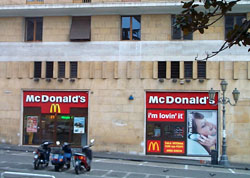 The
paper reports on the epidemic of obesity among Neapolitans. A survey
of 659 Neapolitan men showed that 50% were overweight with 16 % of that
group being ranked as obese. Among 6,300 women in the study, 43% of
the women between ages 40 and 59 were 19% over their ideal body weight;
between ages 50-64, 46% were 27% over their ideal weight. The numbers
for children are especially alarming, and I think the paper has made
a mistake, or at least made it difficult to interpret. They say that
"between the ages of 6 and 11, the 'obesity rate' is 23%". That is unclear
to me. Are 23% of children between the ages of 6 and 11 obese? That
would be a disaster, I think. Anyway, I haven't seen that many roly-poly
kids bouncing around the streets. The
paper reports on the epidemic of obesity among Neapolitans. A survey
of 659 Neapolitan men showed that 50% were overweight with 16 % of that
group being ranked as obese. Among 6,300 women in the study, 43% of
the women between ages 40 and 59 were 19% over their ideal body weight;
between ages 50-64, 46% were 27% over their ideal weight. The numbers
for children are especially alarming, and I think the paper has made
a mistake, or at least made it difficult to interpret. They say that
"between the ages of 6 and 11, the 'obesity rate' is 23%". That is unclear
to me. Are 23% of children between the ages of 6 and 11 obese? That
would be a disaster, I think. Anyway, I haven't seen that many roly-poly
kids bouncing around the streets.
But you
never know. On the same page is an entire article devoted to the opening
of a new fast-food chain in Naples. This one is Pans & Company,
a Spanish company that will open franchises shortly at four locations
in Naples. It is part of a plan to have 20 such eateries in the Campania
region up and running within the year. They will employ about 500 young
people just entering the job market with low-level managers going to
Barcelona for a period of training. The obvious comparison is with McDonald's,
which has opened a number of places in Naples in the last few years.
The Spanish competition in Naples is really an extension of a campaign
started ten years ago in Spain to provide a so-called "Mediterranean
diet" within a fast-food format—or, as the paper says, "bocadillos
instead of hamburgers".
Cronache
di Partenope; Neapolitan Legends;
Castel dell'Ovo (2); Vergil (3)
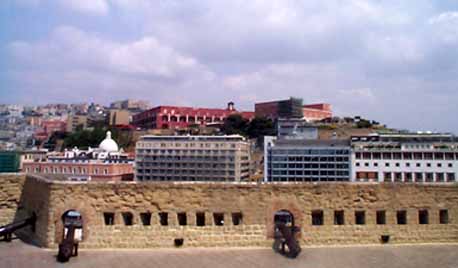 Yesterday, I tidied up a few loose ends in my mind concerning the
Castel dell'Ovo (Egg Castle) in Naples (see here).
First of all, on the ramparts are some cannon positioned such that they
would fire in at the city and not out to sea (as one might expect in
a fortress meant to protect against attack by naval forces). It turns
out that the ones you see up there today were put there for ornamentation,
having been recovered from the bottom of the bay of Naples at a point
some ship went to a watery grave centuries ago. Yesterday, I tidied up a few loose ends in my mind concerning the
Castel dell'Ovo (Egg Castle) in Naples (see here).
First of all, on the ramparts are some cannon positioned such that they
would fire in at the city and not out to sea (as one might expect in
a fortress meant to protect against attack by naval forces). It turns
out that the ones you see up there today were put there for ornamentation,
having been recovered from the bottom of the bay of Naples at a point
some ship went to a watery grave centuries ago.
Yet, tales
of guns from the castle taking pot-shots at the city are not entirely
false. Around the year 1500, when the French and Spanish were belligerently
disputing the future of Naples, the Spanish parked their artillery on
the height of Mount Echia, the cliff directly across from the small
island of Megaride (where the Egg Castle is situated)—only about
200-300 yards as the crow flies—and shelled the Angevin French
in the castle, who, of course, returned fire. The only thing that would
happen today if you could fire those cannon would be that you would
take out the row of luxury hotels that have sprouted like poisonous
mushrooms since the new seaside road was built a century ago. They are
so tall that they obscure the original cliff face of Mount Echia, the
height that was so enchantingly beautiful 2,500 years ago that the Greeks
chose it for their city, Parthenope. One barrage would do it (see photo,
above).
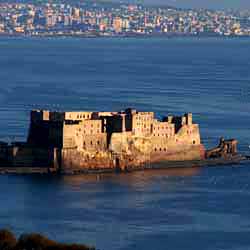 Many
of the legends having to do with the Castel dell'Ovo— indeed,
with Naples, itself —including those recounted by Matilde Serao
in her Neapolitan Legends (see here)
about the poet Virgil, his magical powers,
his connection with Naples, etc.—come from an anonymous work written
in the mid–1300s entitled la Cronaca di Partenope (The
Chronicle of Parthenope), or Croniche de la inclita Cità de
Napole. It is here that we learn of the origins of Virgil's powers—how
he wandered into an enchanted cave on Mt. Barbaro near Naples and found
the wizard, Creon, using his book of magical recipes as a pillow for
a short snooze. Virgil absconds with the manual and the rest is mythology.
(No, I don't know if the Creon in question is (1) the son of Lycaethus,
king of Corinth and father of Glauce or Creusa, the second wife of Jason,
or (2) the son of Menoeceus and king of Thebes who had Antigone buried
alive. I suspect it was another Creon, but you never know—wizards
can fool you.) Many
of the legends having to do with the Castel dell'Ovo— indeed,
with Naples, itself —including those recounted by Matilde Serao
in her Neapolitan Legends (see here)
about the poet Virgil, his magical powers,
his connection with Naples, etc.—come from an anonymous work written
in the mid–1300s entitled la Cronaca di Partenope (The
Chronicle of Parthenope), or Croniche de la inclita Cità de
Napole. It is here that we learn of the origins of Virgil's powers—how
he wandered into an enchanted cave on Mt. Barbaro near Naples and found
the wizard, Creon, using his book of magical recipes as a pillow for
a short snooze. Virgil absconds with the manual and the rest is mythology.
(No, I don't know if the Creon in question is (1) the son of Lycaethus,
king of Corinth and father of Glauce or Creusa, the second wife of Jason,
or (2) the son of Menoeceus and king of Thebes who had Antigone buried
alive. I suspect it was another Creon, but you never know—wizards
can fool you.)
[There
is a critical edition of the Cronaca di Partenope, edited by
Antonio Altamura and published in 1974 by S.E.N. in Naples. That stands
for Società Editrice Napoletana. They are no longer in
business. I see a trip to the used-book shops coming up.]
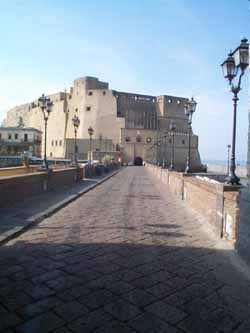 Virgil
is said to have taken the first egg laid by a hen, put it in a glass
amphora, and placed that in a finely wrought metal cage suspended from
a beam braced against the walls of a small secret chamber built especially
for that purpose within the castle. As long as the egg remained intact,
the city was safe. Virgil, thus, joins the list of select protectors
of the city, including the original siren, Parthenope and the more recent
Christian protector, the patron saint of Naples, San Gennaro—St. Januarius. Virgil
is said to have taken the first egg laid by a hen, put it in a glass
amphora, and placed that in a finely wrought metal cage suspended from
a beam braced against the walls of a small secret chamber built especially
for that purpose within the castle. As long as the egg remained intact,
the city was safe. Virgil, thus, joins the list of select protectors
of the city, including the original siren, Parthenope and the more recent
Christian protector, the patron saint of Naples, San Gennaro—St. Januarius.
Interestingly,
even if there were an egg in that castle, it would be a second generation
one. At the time of Queen Joan I of Naples (1326-82)—shortly after
the Chronicle of Parthenope was written—a devastating storm
wrecked much of the Castel dell'Ovo, even destroying the natural arch
that joined the two parts of the island. Joan had to ensure the population
that it was because the egg had broken, but that she had personally
gone through the same magic ritual as Virgil, putting a second protective
egg in place in the same spot. The populace was calmed.
Tennyson,
A.

If it weren't
for Mt. Vesuvius (and other volcanoes, I suppose), I would not have
found out how the gruesome gladiatorial games that the Romans enjoyed
so much came to an end.
In researching
the Geology of the Bay of Naples, I came
across abundant material, of course, on the atmospheric effects of volcanic
eruptions. Somewhere, I had read a verse by Tennyson, used (in the source
I filched it from) to describe the eruption of Krakatoa in the late
nineteenth century.
Accordingly, I wrote:
"And the
great explosion of Krakatoa in Java in 1883 produced atmospheric effects
on a global scale and
even more poetry—this time by Tennyson:
'Had
the fierce ashes of some fiery Peak
Been hurled so high they ranged round the World?
For day by day through many a blood-red eve
The wrathful sunset glared.' "
Tennyson
 I left
it at that, just the way I had copied it. It sounded good and very
Krakatoa-like. However, just the other day, a kind gentleman from
Japan, Dr. M. Iguchi from Tokyo, wrote me and asked (1) if the use
of word 'World' was correct, for he recalls reading the same verse
with 'globe'', and (2) if I would be so kind as to tell him if that
was the entire poem or if it was an excerpt from a longer work, and,
if so, which one? I left
it at that, just the way I had copied it. It sounded good and very
Krakatoa-like. However, just the other day, a kind gentleman from
Japan, Dr. M. Iguchi from Tokyo, wrote me and asked (1) if the use
of word 'World' was correct, for he recalls reading the same verse
with 'globe'', and (2) if I would be so kind as to tell him if that
was the entire poem or if it was an excerpt from a longer work, and,
if so, which one?
To work,
to work. Indeed, I had misquoted the line. (But, of course, it is really
the fault of the person I copied it from!) It is, in fact, 'globe'.
The four brief lines come from a much longer poem (80 lines, in all)
by Tennyson. The poem is entitled "St. Telemachus" and is from Tennyson's
last published volume, The Death of Oenone, Akbar's Dream, and Other
Poems, which appeared in 1892.
Not only
did I misquote the line, but I skipped one line and truncated another,
such as to destroy the original context. The first 11 lines are:
Had
the fierce ashes of some fiery peak
Been hurl'd so high they ranged about the globe?
For day by day, thro' many a blood-red eve,
In that four-hundredth summer after Christ,
The wrathful sunset glared against a cross
Rear'd on the tumbled ruins of an old fane
No longer sacred to the Sun, and flamed
On one huge slope beyond, where in his cave
The man, whose pious hand had built the cross,
A man who never changed a word with men,
Fasted and pray'd, Telemachus the Saint. |
St. Telemachus,
also known as Alamachius was a monk who was called by an inner voice
to go to Rome in about the year 400 a.d. His attended a gladiatorial
combat and tried to stop the combatants from killing each other. He
was stoned to death by the angry mob, but the emperor Honorius (who
ruled from 395 to 423), a Christian, got the point and banned the games.
Thus, St. Telemachus' place in Christian history is as the one responsible
for ending the gladiator games.
Thank you,
Mt. Vesuvius.
Odyssey,
The ; sailing; sirens
Then
all at once the wind fell, and a calm
came over all the sea, as though some power
lulled the swell.
The crew were on their feet
Briskly, to furl the sail, and stow it; then,
each in place, they poised the smooth oar blades
and sent the white foam scudding by…
[The
Odyssey. Translator: Robert Fitzgerald]
|
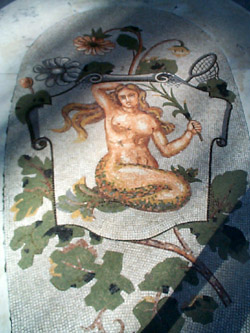
At that
point, Ulysses has his men stuff beeswax in their ears and has himself
lashed to the mast of his ship, all the better to resist the tempting
song of the sirens.
I think
all that is supposed to have happened along the Amalfi coast (well before
there was an Amalfi, of course). My friend, Bill, got his good ship,
Down East, into the water at Nisida in the Bay of Pozzuoli the
other day and set out for Amalfi and beyond. He made it across the Bay
of Naples in good time, rounded Cape Campanella and headed by the small
isle named Li Galli, but originally Sirenuse, from the
shores of which the sirens Ligeia, Leukosia, and Parthenope made their
futile pitch.
Bill reports
that you can still hear police and ambulance sirens from the Amalfi
coast road if you sail close enough to shore. Also, sailing—that
was the real problem. The local maritime wisdom that the wind dies down
at noon along that coast ("…as though some power lulled the swell…")
and makes you break out the oars turned out to be true. Just past the
cape and just off the magic isle, the wind died and Bill had to break
out the engine. Ah, there is nothing like the smell of diesel fuel at
sea to make you sing with Tennyson that you aim "to sail beyond the
sunset, and the baths of all the western stars".
Procida
(2)
Uncovering
the Bronze Age of Procida
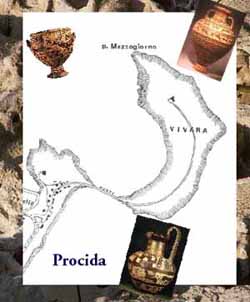 The
tiny island of Procida lies inconspicuously moored next to its big sister,
Ischia, in the Bay of Naples; yet, even this little isle has a smaller
relative: Vivara. Separated from Procida by a few meters of water and
now connected to it by bridge, Vivara, a crescent-shaped remnant of
the rim of an ancient volcanic crater, is now a nature preserve, one
of the last unspoiled bits of greenery and wildlife havens in the area
—and as a result of recent archaeological work, a place
to catch a glimpse of the first great civilization of the ancient Greeks:
Mycenae. The
tiny island of Procida lies inconspicuously moored next to its big sister,
Ischia, in the Bay of Naples; yet, even this little isle has a smaller
relative: Vivara. Separated from Procida by a few meters of water and
now connected to it by bridge, Vivara, a crescent-shaped remnant of
the rim of an ancient volcanic crater, is now a nature preserve, one
of the last unspoiled bits of greenery and wildlife havens in the area
—and as a result of recent archaeological work, a place
to catch a glimpse of the first great civilization of the ancient Greeks:
Mycenae.
In 1470
B.C. the Greek island of Thera exploded and put a cataclysmic end to
the grand Minoan civilization of nearby Crete. In a sense, it was the
end of what might be called the “southern dimension” of
great early cultures, the last link in a chain that had started with
the Sumerians and carried on through the Babylonians, Egyptians and
Minoans. The end of Crete left a void that would be filled by the proto-Greeks,
a branch of the Indo-European peoples who a few centuries earlier had
started drifting south into the Greek mainland. By 1400 b.c.—a
thousand years before Aristotle and Plato, and many centuries before
the great city-states of Greece or any of the renowned Greek cities
in Italy such as Cuma and Paestum—these
early Greeks had formed a league of separate kingdoms centered on Mycenae
on that part of the Greek mainland known as the Peloponnese.
This is
the civilization from which stems much of our vast Greek cultural heritage
and familiar repertoire of Greek mythology; indeed, Mycenae—today
a small town near the original site, a few miles inland from the Gulf
of Argolis in the foothills guarding the road to Corinth—was the
home of “proud Agamemnon” who rallied his fellow princes
to sail forth and besiege Troy to avenge the abduction of Helen in 1200
b.c. Mycenae, then, turned out to be the dominant Mediterranean civilization
for almost 400 years, from 1450 to 1100 b.c., and though there was not
yet a single major city anywhere in Italy (the first would be built
by the Etruscans in about 900 b.c.) the Mycenaeans carried on flourishing
trade with small outposts scattered on Sicily and the islands and coastal
areas of southern Italy. One such outpost was Vivara.
The Bronze
Age inhabitants of Vivara of 1500 BC looked out on a coastline and bay
somewhat different than what we see today. Indeed, even since the time
of the Romans—much less a millennium and a half earlier—the
waters in the Bay of Naples have risen about 6 meters. This accounts
for the ruins of submerged Roman port facilities
in nearby Baia, for example. Vivara, itself, was joined to Procida by
land at the period in question.
The first
archaeological digs on the island (carried out in the 1930s) revealed
remnants of a system of Bronze Age huts on what would then have been
the plateau of the island as well as on the heights. One of the most
interesting finds at the time consisted of two clay jars bearing traces
of ornamental varnish—interesting in that they were of the same
type as found on Filicudi, an island further to the south in the
Aeolian archipelago north of Sicily. It was pottery of a type clearly
Greek/Mycenaean and datable to the middle of the second millennium before
Christ. Mycenaean pottery—as well as the produce it contained,
such as wine and olives—was known to have been highly valued and
to have been exported throughout the eastern Mediterranean and at least
as far west as Sicily.
Such finds
on Filicudi and then on Vivara are now taken as evidence of trade between
Mycenae and Italy even at such an early date, trade supported by a network
of coastal and island trading posts. Much of that commerce was concerned
with the search for metals, and on Vivara, besides ceramic shards, remnants
of habitations, jewelry and bits of weaponry of early Greek origin,
there are signs that the area was, indeed, mined for copper at some
time in the distant past—and there even appears to have been a
foundry of sorts. This would be in keeping with collateral archaeology
elsewhere in Italy, which indicates that the peninsula was somewhat
of a Bronze Age mine for Mediterranean cultures to the south.
Starting
in the early 1990s, archaeological research on Vivara has been in collaboration
with the Orientale University of Naples and the Naples Superintendent
for Archaeology. It is work undertaken with enthusiasm and intensity
by university archaeology students on the site. Their recent discoveries
include the floor and collapsed tile roof of a large structure, uncovered
half a meter below the surface; also, they have found a series of clay
tokens of varying shapes and sizes. The tokens were stacked and had
apparently been joined by a long-since decayed ring of some sort, indicating
that they were used as a means to keep track of merchandise and transactions.
[More
on Procida]
San
Gennaro dei Poveri
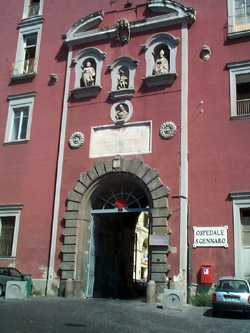 A
few doctors and other staff of the San Gennaro dei Poveri hospital
in Naples (San Gennaro is the patron saint of Naples; dei poveri
means "of the poor") cleaned up the ancient and purportedly original
tomb of the saint near the hospital grounds the other day. It is a catacomb-like
affair embedded in the side of a hill. The paper complimented the good
deed, which was done in the spirit of the city's annual "Monuments in
May" display of historic treasures, but remarked that in typical fashion,
the tomb will now no doubt remain closed for another 50 years—the
amount of time that had passed since the last time it was cleaned. A
few doctors and other staff of the San Gennaro dei Poveri hospital
in Naples (San Gennaro is the patron saint of Naples; dei poveri
means "of the poor") cleaned up the ancient and purportedly original
tomb of the saint near the hospital grounds the other day. It is a catacomb-like
affair embedded in the side of a hill. The paper complimented the good
deed, which was done in the spirit of the city's annual "Monuments in
May" display of historic treasures, but remarked that in typical fashion,
the tomb will now no doubt remain closed for another 50 years—the
amount of time that had passed since the last time it was cleaned.
The hospital,
itself, is interesting, historically, but totally neglected compared
to the medieval and Baroque points of interest in the main part of the
city. It is very much off the beaten track and not at all in a part
of the city that you and I would choose to stroll around—the Sanità
zone of the city just beneath the Capodimonte hill.
Though
it is now merely a hospital for the poor or indigent, historically it
was the first Hospice for Poor. It was founded in 1667 and intended
to be a great "poor house", a place for at least some of the city's
10,000 mendicant poor (that comes out to about six or seven percent
of the entire population of the city of the late 1600s). It was a forerunner
of the much more ambitious project along the same lines, the gigantic
Royal Hospice for the Poor started by the Bourbons
in the 1750s.
The reasons
behind the desire to build the poor house, properly called Ospizio
dei Santi Pietro e Gennaro, shed some light on the worldview of
people in that day and age, at least in this part of the world. The
plague of 1656 had devastated the city, and a large segment of the population
had died; those who could actually afford to do so simply moved out
of the city; jobs went undone and the economy—not doing too well,
anyway, in these late stages of the Spanish empire of which Naples was
a part—was a disaster. The plague was generally viewed as divine
retribution for the sins of the city, and one way to regain divine favor
was to engage in votive building (such as the two large spires at Piazza
del Gesù Nuovo and Piazza San Domenico Maggiore—
both from the late 1600s) and the construction of charitable institutions
such as the Hospice of San Gennaro. Many remembered the dying words
of Orsola Benincasa (1547-1618), a Neapolitan nun, who predicted a severe
punishment from God unless the city did something to help the poor.
The hospice
was never intended to accommodate the thousands of poor roaming the
streets, but it did manage to handle about 800 at any given time. The
plan was not just to build a gigantic soup-kitchen and flop-house; it
was set up to provide shelter, food and education, including practical
trade instruction, generally literacy and even music. Much of that philosophy
was incorporated into workings of the larger Bourbon hospice in the
18th century. The plan, too, was to help clear the streets of the most
obvious walking reminders of endemic poverty in the Naples of that period
by making a distinction between the home-grown poor (that you could
take care of in such an institution) and the wandering beggars from
elsewhere (whom you could then keep—or try to keep—out of
the city).
The San
Gennaro hospice did not fail, but it was obviously not up to the task.
That is the main reason behind the later Bourbon hospice. Yet, the San
Gennaro hospice was a useful social institution through the entire 18th
and even much of the 19th century. Times change and such things as "poor
houses" are not part of modern Western society's way of handling social
ills. The hospice became, officially, simply a hospital in 1939. But
it still does a job.
Veiled
Christ; (di) Sangro, Raimondo; Sanmartino,
Giuseppe
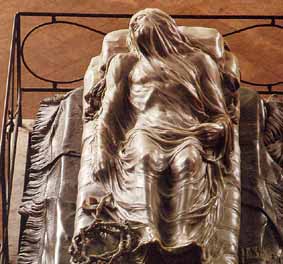 A friend asked me recently if I had ever heard the story
that the sculptor of the famous Veiled Christ within the Sansevero
chapel had been "rewarded" by the person who commissioned the work by
having his eyes put out so that he would never again create such a work
of beauty! I said, no, that I had not heard that story—or even
that kind of repugnant story—except in connection with Ivan the
Terrible and a sculptor connected with the construction of the Kremlin
(as I recall). A friend asked me recently if I had ever heard the story
that the sculptor of the famous Veiled Christ within the Sansevero
chapel had been "rewarded" by the person who commissioned the work by
having his eyes put out so that he would never again create such a work
of beauty! I said, no, that I had not heard that story—or even
that kind of repugnant story—except in connection with Ivan the
Terrible and a sculptor connected with the construction of the Kremlin
(as I recall).
The sculptor
of the Veiled Christ was Giuseppe Sanmartino (1720-93). He created
the masterpiece in question in 1753. His further works throughout the
rest of his life are well documented in any catalogue of Neapolitan
sculpture; they include prominent works in the monastery/museum of San
Marino and the Naples Cathedral (Duomo). His last work appears to have
been in 1792: a sculpture, Moses and Aaron and the Tablets of the
Law, on the entrance of the Church of the Gerolomini.
So much
for that horrid story about being blinded. It set me to wondering, though,
where my friend had come up with such a story. There are a number of
encyclopaedia references and short biographical sketches of Raimondo
di Sangro, Prince of Sansevero (1710-1771), the gentleman who commissioned
the Veiled Christ for his family chapel. He is listed—when
briefly—as an "inventor and the person who imported freemasonry
into the Kingdom of Naples" and—when at length—with rambling
descriptions of his reputation as a sorcerer, inventor, charlatan, alchemist,
friend of Charles III of Bourbon, even lover of music. In that regard,
he is said to have bought young boys with good voices from their poverty-stricken
families and castrated them to preserve their fine soprano voices as
castrati—in search of the "primordial androgyny". God help us.
Even the infamous Count of Cagliostro at his trial before the Inquisition
court in Rome in 1790 is said to have claimed that everything he knew
about the evil arts and alchemy he learned from di Sangro.
Raimondo
di Sangro was no doubt the kind of mysterious and powerful person that
inspired awe among the masses of the mid-1700s in Naples. A good description
to that effect is found in Benedetto Croce's Storie e Leggende napoletane.
Croce says that di Sangro—for the masses that live in the narrow
by-ways of the inner part of the city where the chapel is located—was
the perfect comparison with Faust, who sold his soul to the devil for
magical powers. Croce repeats a number of rumors about di Sangro: that
he murdered seven cardinals of the church and had furniture made from
the bones and skin; that he could reduce metals and marble to dust by
touching them; and—here it is—that he had the eyes removed
of the sculptor of the Veiled Christ.
That remarkable
piece of sculpture, by the way, always evokes the same comment: How
did he make the veil? How is it that you see the features of the Savior
beneath the veil? Did Sanmartino sculpt it that way? How is that possible?
One hypothesis is that the finished staute was covered with a cloth
and that the cloth was permeated with a solution that crystalized as
calcium carbonate, creating the veil. Only Sanmartino knows for sure.
With all
due respect to one of the most beautiful works of art I have ever seen,
the Veiled Christ is surrounded by an almost Barnumesque display of
weidness. In the ex-secret chamber of the chapel, there are the remains
of a man and woman, mummified such that the inner organs and the arteries
and veins of their circulatory systems are preserved and on display.
Whether or not the two persons on display were di Sangro's servants
whom he put to death for minor disobedience—as rumor has it—is
almost irrelevant. Indeed, a strange duck, Raimondo di Sangro,
Prince of Sansevero. He even wrote his own epitaph:
| A
person to be admired, born to dare…illustrious in the sciences,
mathematics and philosophy, unsurpassed in discovering the secrets
of nature and esteemed master of the military arts…this
temple is dedicated to his everlasting memory. |
Genovesi,
Antonio
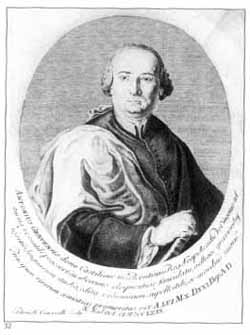 Most
students at one time or another have had the feeling that the professor
up there in front was rambling on in a foreign language. And so it really
was for many centuries in European universities, where lectures were
routinely held in Latin. Antonio Genovesi's students of political economy
at the University of Naples in 1755, thus, must have been pleasantly
surprised when the professor delivered his lectures in Italian. He was
"the first," according to a number of sources, though it is not clear
exactly what that means—the first in Naples, the first
on the Italian peninsula, the first in Europe. It is not even clear
if he lectured in the northern language of Dante or the home-grown Neapolitan
variety of Italian, a vibrant and living language at the time with an
impressive literary history of its own. Whatever the case, it still
made old (he was 43!) professor Genovesi a pretty good guy, I'm sure. Most
students at one time or another have had the feeling that the professor
up there in front was rambling on in a foreign language. And so it really
was for many centuries in European universities, where lectures were
routinely held in Latin. Antonio Genovesi's students of political economy
at the University of Naples in 1755, thus, must have been pleasantly
surprised when the professor delivered his lectures in Italian. He was
"the first," according to a number of sources, though it is not clear
exactly what that means—the first in Naples, the first
on the Italian peninsula, the first in Europe. It is not even clear
if he lectured in the northern language of Dante or the home-grown Neapolitan
variety of Italian, a vibrant and living language at the time with an
impressive literary history of its own. Whatever the case, it still
made old (he was 43!) professor Genovesi a pretty good guy, I'm sure.
Genovesi
was one of the prominent members of the Neapolitan Enlightenment of
the mid-1700s, a school that includes Gaetano
Filangieri, Vincenzo Cuoco and Vincenzo Russo . As a young man he was educated
for the church but gave that up. He then studied law but eventually
devoted himself to philosophy. That is not as abstract as it sounds.
Genovesi wrote the first systematic and complete work in Italian on
economics, his Delle lezioni di commercio (1767) and was, in
fact, the first professor of the newly founded Chair of Political Economy
in Naples in 1754, the first such chair at a European university. He
stressed that human wants were the foundation of economic theory and
that labour was the source of wealth. He preached the education of the
masses (no doubt the reason behind his lectures in Italian) and the
abolition of feudalism. He wrote his early works in Latin: Disciplinarum
metaphysicarum elementa (1743) and Elementa artis logico-criticae
(1745). His major work, the Lezioni di commercio, was in Italian,
as was his Philosophical Meditations (1758). He was born in 1712
and died in 1769.
San
Martino vineyard
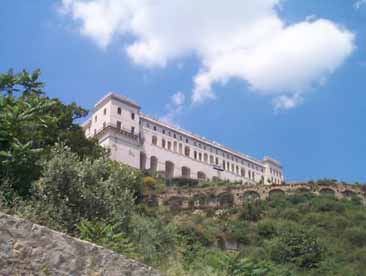 The Museum of San Martino is one
of the most evident landmarks in Naples—a huge, white ex-monastery
perched on the Vomero hill, visible from almost everywhere in the city
and from all points on the waters of the Bay of Naples. What is not
so evident is that the area directly below the museum, extending around
the slope to provide a 260-degree panorama to the east, south and west
is a 20-acre oasis called the Vineyard of San Martino. The Museum of San Martino is one
of the most evident landmarks in Naples—a huge, white ex-monastery
perched on the Vomero hill, visible from almost everywhere in the city
and from all points on the waters of the Bay of Naples. What is not
so evident is that the area directly below the museum, extending around
the slope to provide a 260-degree panorama to the east, south and west
is a 20-acre oasis called the Vineyard of San Martino.
| The
vineyard rises steeply from 300 feet above sea level to 600 feet
through a series of terraces, starting from in back of the buildings
along the street named Corso Vittorio Emanuele and stopping directly
at the wall of the museum itself. Originally, the grounds were
part of the monastery, a vast area set in isolation above the
city. That situation prevailed for centuries until the late 1800s
when the newly unified Italian state passed a series of laws expropriating
a great amount of property belonging to the Catholic church in
Italy and, thus, essentially closing many monasteries. Since the
late 1860s, San Martino has been a museum owned and operated by
the state. |
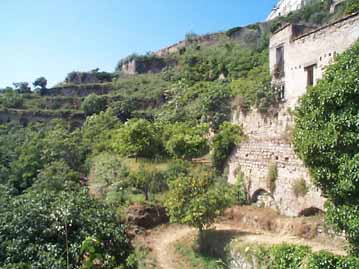 The
vineyard is in private hands, however, and the owner seems intent on
keeping it intact, isolated and as green as possible. The division of
the vineyard from the old monastery in the late 19th century unfortunately
led to the lack of an integrated plan to care for the grounds, particularly
where run-off from rainfall on such a steep slope is concerned. There
have been a number of earthslides over the last century, with water
building up behind some terrace walls and then eventually bursting them.
Restoration, however, of a large section of the terrace walls below
the museum is in progress, and much of the property is still under cultivation
as a genuine, producing vineyard. The most striking thing about the
vineyard is that it rests above a city of millions, yet it is pastoral,
almost surreally so—an unexpected patch of green and quiet. The
vineyard is in private hands, however, and the owner seems intent on
keeping it intact, isolated and as green as possible. The division of
the vineyard from the old monastery in the late 19th century unfortunately
led to the lack of an integrated plan to care for the grounds, particularly
where run-off from rainfall on such a steep slope is concerned. There
have been a number of earthslides over the last century, with water
building up behind some terrace walls and then eventually bursting them.
Restoration, however, of a large section of the terrace walls below
the museum is in progress, and much of the property is still under cultivation
as a genuine, producing vineyard. The most striking thing about the
vineyard is that it rests above a city of millions, yet it is pastoral,
almost surreally so—an unexpected patch of green and quiet.
Pignatelli,
Villa
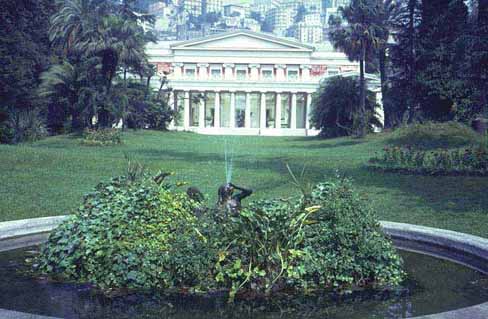 The most striking building along the Riviera di Chiaia, the road
bounding the north side of the Villa Comunale
on the sea front between Mergellina and Piazza Vittoria is certainly
the Museo Principe di Aragona Pignatelli Cortes, known to Neapolitans,
simply, as Villa Pignatelli. The most striking building along the Riviera di Chiaia, the road
bounding the north side of the Villa Comunale
on the sea front between Mergellina and Piazza Vittoria is certainly
the Museo Principe di Aragona Pignatelli Cortes, known to Neapolitans,
simply, as Villa Pignatelli.
In 1826,
Ferdinand Acton entrusted to Pietro Valente the task of building a Greco-Roman
style residence that would then, in the English fashion of the day,
be the centerpiece of a park. The intention of Valenti and the owner
was to create a kind of Pompeian villa with the central atrium moved
to the front of the building where Doric columns would then provide
the only opening onto the gardens. The magnificence of these columns
still strikes the eye of the casual passer-by today from the avenue
fifty yards away.
The property
has changed hands a few times since the construction of the villa. It
was bought in 1841 by Karl Meyer von Rothschild of the German family
of financiers; then in 1867 it came into the hands of the Duke of Monteleone,
Diego Aragona Pignatelli Cortes, whose widow then willed it to the Italian
state in 1952. The villa today has managed to preserve and maintain
intact the fine gardens in front of the building. The grounds house
a coach museum, a collection of French and English vehicles from the
eighteenth and nineteenth century. It is also the site of numerous art
shows.
risanamento
(2), Corso Umberto, urbanology 4
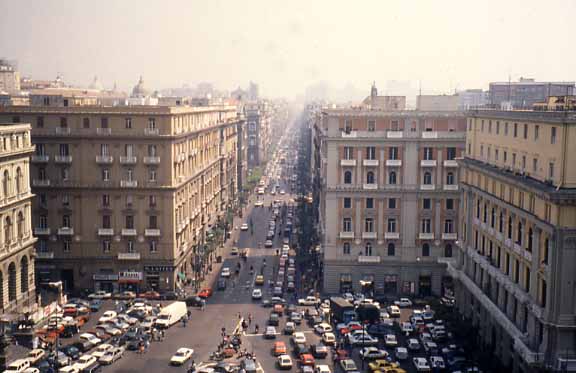 The
urban renewal that swept Naples in
the last decades of the nineteenth century went by the pleasant name
of ‘Risanamento', meaning, literally, ‘making healthy
again’. In the name of achieving this worthy aim, a large number
of old —even ancient— structures were cleared away. In some
cases, the results were quite pleasant; a case in point would be the
magnificent Galleria Umberto finished
in 1890. Some controvery, however, surrounded the massive clearing of
a wide swath of buildings between what is now Piazza Giovanni Bovio
(called, simply, Piazza della Borsa—the stock exchange—by
most Neapolitans) and the central train station, over a mile away, in
order to build a broad and modern boulevard named Corso Umberto
and called by most the rettifilo— the straight line. The
urban renewal that swept Naples in
the last decades of the nineteenth century went by the pleasant name
of ‘Risanamento', meaning, literally, ‘making healthy
again’. In the name of achieving this worthy aim, a large number
of old —even ancient— structures were cleared away. In some
cases, the results were quite pleasant; a case in point would be the
magnificent Galleria Umberto finished
in 1890. Some controvery, however, surrounded the massive clearing of
a wide swath of buildings between what is now Piazza Giovanni Bovio
(called, simply, Piazza della Borsa—the stock exchange—by
most Neapolitans) and the central train station, over a mile away, in
order to build a broad and modern boulevard named Corso Umberto
and called by most the rettifilo— the straight line.
Cutting
the downtown area in half separated the port area and the old Market Place from the rest of the city.
Whether or not that was truly the solution to what seemed like intractable
conditions of overcrowding, it was done—much in keeping with similar
urban renewal projects in other European cities in the same period.
The Italian word for the operation is sventramento, meaning “gutting”.
The negative connotations of that world were lost on no one. The architectural
results, paralleling the social results, were by general consensus,
mixed.
Piazza
Bovio, itself, is dominated by the Stock Exchange building. It was
built in 1895 and is the work of the architect Alfonso Guerra. Only
after it was decided that there would be no place for such a building
at Piazza Municipio was the Stock Exchange
built at Piazza Bovio. The center of the square used to
showcase the Fountain of Neptune, a work from 1601 by Bernini
and Naccherino, done to a design by the great Neapolitan architect Domenico
Fontana. That fountain has now been moved back to one of its previous
sites on via Medina near Piazza Municipio. From Piazza
Bovio all the way to the train station, thus, there is an unbroken
chain of similar, somewhat monotonous, turn-of-the-century architecture,
with a few pleasant exceptions such as the neoclassical main building
of the University of Naples, located one
block away from Piazza Bovio on the north side of the street. Further
on, similarly, there is an interesting configuration of four identical
buildings occupying the four corners of Piazza Nicola Amore. They are
called the "quadruplets" by Neapolitans.
Vanvitelli,
Luigi; Calabritto, Palazzo
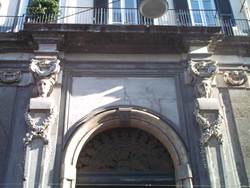 I
had one of those revelatory moments the other morning, where you step
back and really look at something for the first time and notice it instead
of strolling nonchalantly by. Just off of Piazza Vittoria, the
square on the seaside at the east end of the Villa Comunale,
is a street named via Calabritto; it runs for one block to Piazza
dei Martiri. I looked up at it for a second and it hit me: this
building isn't on the block—this building is the
block. From the main road to Piazza dei Martiri, the building—named
Villa Calabritto—occupies the entire east side of the street.
It is three stories high, but these are three 18th-century stories,
each one almost twice as high as a modern one. The entrance is framed
by classically clean columns with a lovely arch over it; the entrance
is at least 25-feet high and wide enough let a coach pulled by, say,
a team of four horses turn easily in and through to the courtyard. I
walked into the entrance and said something intelligent to a gentleman
standing there. I think I said, "Gee, some building, huh?" He smiled
and said, "Vanvitelli". I
had one of those revelatory moments the other morning, where you step
back and really look at something for the first time and notice it instead
of strolling nonchalantly by. Just off of Piazza Vittoria, the
square on the seaside at the east end of the Villa Comunale,
is a street named via Calabritto; it runs for one block to Piazza
dei Martiri. I looked up at it for a second and it hit me: this
building isn't on the block—this building is the
block. From the main road to Piazza dei Martiri, the building—named
Villa Calabritto—occupies the entire east side of the street.
It is three stories high, but these are three 18th-century stories,
each one almost twice as high as a modern one. The entrance is framed
by classically clean columns with a lovely arch over it; the entrance
is at least 25-feet high and wide enough let a coach pulled by, say,
a team of four horses turn easily in and through to the courtyard. I
walked into the entrance and said something intelligent to a gentleman
standing there. I think I said, "Gee, some building, huh?" He smiled
and said, "Vanvitelli".
If all
you know about Luigi Vanvitelli (1700-73) is that there is, in Naples,
a square and Metropolitana train station at that square named for him,
that's not enough. It's good but not enough. Not that Vanvitelli wouldn't
like the metro station. Like most of his buildings, the station is much
larger and more magnificent than it needs to be. He might wonder at
the electric lights, the train itself, and the escalators, but he might
appreciate the grandeur.
Vanvitelli
was born in Naples, the son of the Dutch painter Gaspard van Wittel;
thus, "Vanvitelli" is an Italianization. Vanvitelli studied in Rome
and gained a reputation there before moving back to Naples: he designed
the façade of the church of St John Lateran in 1732, worked on
the consolidation of the dome of St Peter's in the Vatican, and helped
decorate the Fontana di Trevi. In 1751 he moved to Naples to
work for Charles III of Bourbon. Vanvitelli's best-known work is the
Royal Palace at Caserta, the so-called "Versailles of Italy". In the
city of Naples, itself, he helped redesign the Royal
Palace in 1753, the magnificent building that fronts on Piazza
Plebiscito and sits on the site of an earlier Spanish vice-regal
residence built by Domenico Fontana. In the 1760s he redesigned the
square now known as Piazza Dante and built the ornate semi-circular
building, now a boarding school named for Victor Emmanuel II, that bounds
that square on the east.
Vanvitelli
was so prolific in Naples and, indeed, throughout Italy, that Palazzo
Calabritto is as neglected as an afterthought on most lists of his works.
He set to work on it in 1756, essentially rebuilding an earlier structure
on that site. The main entrance, mentioned above, is now on one of the
side streets leading to the main square, Piazza dei Martiri. If you
walk the length of the block to that square and turn the corner, what
used to be the servants entrance now sits on the main square. The main
entrance and secondary one have two separate street addresses, but the
building is one, as you can see if you walk in either entrance to the
courtyard and look at the entire building from the back, as it were.
Nothing
marks the building as a work by one of the greatest of all Italian architects,
and though the façade seems to have been redone recently—or
at least cleaned—Palazzo Calabritto shows signs of neglect.
One of the main concerns for people interested in preserving this treasure
is the subway train line construction going on along the seaside. Plans
call for a tunnel—considerably below sea level—to go beneath
the street named Riviera di Chiaia for the entire length of the
park (the Villa Comunale) and then turn in and tunnel beneath
(!) Palazzo Calabritto to a new station at Piazza dei Martiri.
Annunziata,
Church (1)—
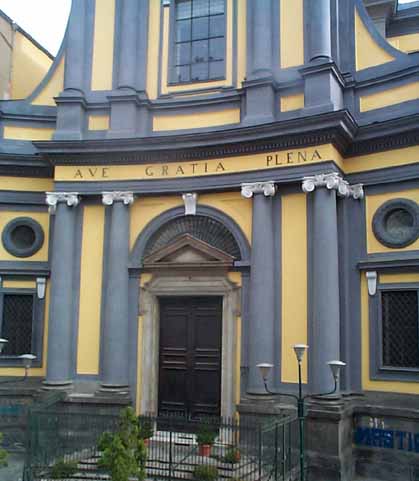 Neapolitan folk tradition says that the origin of the
surname "Esposito" is to be found in the past participle of the verb
"esporre", that is, "esposto", meaning "exposed" or "put out for display".
Thus, originally, so the story goes, abandoned children—left perhaps
in a church—were "exposed" and those with that surname can be
traced back to a foundling at some point. Neapolitan folk tradition says that the origin of the
surname "Esposito" is to be found in the past participle of the verb
"esporre", that is, "esposto", meaning "exposed" or "put out for display".
Thus, originally, so the story goes, abandoned children—left perhaps
in a church—were "exposed" and those with that surname can be
traced back to a foundling at some point.
Generally,
infants who were abandoned in Naples were left on the premises of the
Church of the Annunziata (photo) in the old section of town, not too
far from today's Piazza Garibaldi and the main train station.
Indeed, there are also a great number of people in the Naples phone
book with the surname "Annunziata," so that, too, may have a similar
etymology. I have also heard the strange, quaint (?)—definitely
weird—tale that on the premises of the Church of the Annunziata,
which included a large orphanage, there was at one time a small, revolving
Ferris-wheel-type affair with basket-cribs in place around the perimeter
that each held a child. Periodically, the wheel would be put out and
if you wanted a child, you could "spin the wheel," so to speak, and
look at what was available. (I don't know if that is a true story, but
that is the way I heard it).
[As
a matter of fact—this written some time later—that is not
true, but the real story is just as fascinating.
See here ]
The Annunziata,
itself, goes back to the early 1300s and has always been, in one form
or another, an orphanage. By the mid 1600s, it was a full-fledged home,
church, hospital, and school for such children. In the 1750s, under
Charles III, the entire premises were completely remodeled by a team
of architects that included Ferdinando Fuga, who built the giant Royal
Hospice for the Poor, and Luigi Vanvitelli. The façade of the church is by Vanvitelli,
as is the dome. The church interior is highly ornamental and includes
works, for example, by Giuseppe Sanmartino, the sculpture of the famed
Veiled Christ within the Sansevero Chapel
in Naples.
Traditionally,
children raised by the Annunziata, surviving the staggering infant mortality
rate of earlier times, were called "children of the Madonna" and, in
a sense, there attached to them a certain aura of privilege—as
if they lived in a state of grace. I have read that the Annunziata continued
to function as an orphanage until the 1950s, at which time state social
services took over the task.
Saracen
Towers
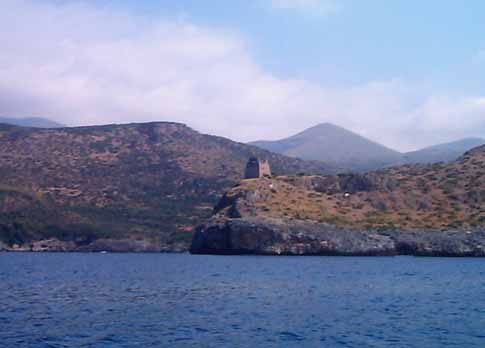 As you approach the Sorrentine coast from the sea, they look like
mere specks, indistinct bits of stone along the shoreline below the
town and high on the slopes of Montechiaro to the north-east. These
are the "Saracen Towers," a reminder of a time when the citizens of
Sorrento had more serious things on their mind than how to carve those
inlaid wooden souvenirs called intarsio. Other examples of these
towers can be seen scattered all along the coasts of Southern Italy—indeed,
from Gaeta to Amalfi, alone, there are more than 350 of them. As you approach the Sorrentine coast from the sea, they look like
mere specks, indistinct bits of stone along the shoreline below the
town and high on the slopes of Montechiaro to the north-east. These
are the "Saracen Towers," a reminder of a time when the citizens of
Sorrento had more serious things on their mind than how to carve those
inlaid wooden souvenirs called intarsio. Other examples of these
towers can be seen scattered all along the coasts of Southern Italy—indeed,
from Gaeta to Amalfi, alone, there are more than 350 of them.
Some may
have been restored and partially incorporated into more modern buildings
such that it is difficult to make out what they originally were. But
as you sail south from Amalfi down the coast of the Campania region,
past the many small modern harbors such as San Marco, Pisciotta, Marina
di Camerotta, etc. and around Cape Infreschi just before Scario, you
come to a stretch of cliff faces and mountains along the coast that
still have no roads and are still isolated. Once the backdrop of modern
buildings disappears, the towers start to stand out—distinct,
visibile and lonely (see photo). They are posted, in some cases, just
a few hundred yards apart, thousands of them ringing all of southern
Italy. The Norman founders of the Kingdom of Two Sicilies started building
them in the 11th century and the Spanish viceroys of the same kingdom
were still building them 500 years later. They all served the single
purpose of watching for an enemy more feared than even the Goths and
Huns who had destroyed the Roman Empire —the Saracens.
"Saracen"
is a vague word; it is possibly a phonetic corruption of 'Syrian', but
what it meant to Italians in the Middle Ages was 'Moslem Invader', whether
the Arabs who rode the initial wave of Islamic expansion into Spain
and Sicily in the 8th and 9th centuries, or the Ottoman Turks who conquered
Constantinople in the 15th century. Indeed, after that traumatic event
for Christianity, the front in the war between the two faiths moved
decisively to the West, and though Moslem thrusts into Europe by the
16th century were largely just harrassment, people here still remembered
that the Saracens in the past had more than once attacked even Rome,
itself. The word "Saracen!" was enough to set the population trembling,
for it was very often the towns along the Sorrentine and Amalfi coasts
that bore the brunt of raids by the likes of Khayr Ad-Din, the feared
pirate known as "Barbarossa"—Red Beard.
Posillipo
(1); Rosebery, Villa
One
of the advantages of living in a big city on a seacoast is that you
don't have to hunt down green urban oases to get away from it all. Those
patches do exist in Naples, to be sure—the Villa
Comunale, the Floridiana, the Vineyard of San Martino , the grounds of the Botanical
Gardens or the Museum of Capodimonte—but
the quickest way is just to get on a boat, preferably a two-hour cruise
up the Posillipo coast to the Isle of Nisida and back, but even a ferry
boat along the same route over to the island of Ischia will do. Even
a row boat—but get out there.
The prominent
city landmarks such as the San Martino Museum, the Castel
Sant'Elmo, the Royal Palace, the
Angevin Fortress, the Castel
dell'Ovo (Egg Castle) are all immediately viewable from the harbor
or shortly after rounding the breakwater and moving west. At the end
of the seaside park called the Villa Comunale is the small harbor of
Mergellina, mentioned in documents from the 13th-century
and besung in a number of Neapolitan Songs. The actual meat of the excursion,
however, is the long stretch of the Posillipo hill and coastline.
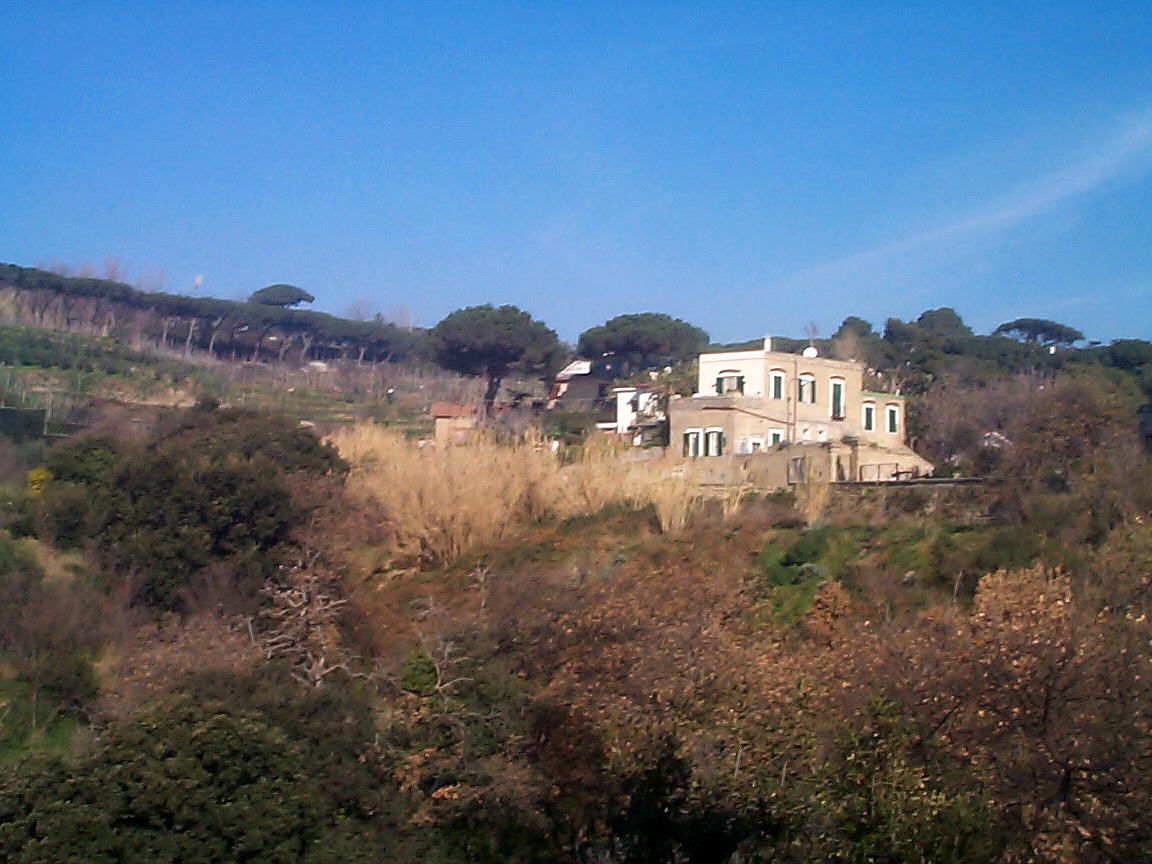 The Greeks first named the rocky,
wooded height at the western end of the Bay of Naples Pausylipon,
meaning "place where unhappiness ends". The area remained largely
undeveloped until a road, via Posillipo, was built between 1812-24.
That road starts at sea-level at the Mergellina harbor and moves up
the coast, roughly parallel to the shore, but it actually angles up
for over two miles to the cliffs at Cape Posillipo some 200 meters above
sea level. Additionally, the road angles in as it rises along the cliff;
thus, by the time it wends its path to the cape, it has put a broad
slope of land between itself and the sea. That is the slope, the broad
swath of land, that you see as you glide west along the coast. Towards
the end of the Posillipo hill, near the cape, some of the land is still
farmland and under active cultivation. The Greeks first named the rocky,
wooded height at the western end of the Bay of Naples Pausylipon,
meaning "place where unhappiness ends". The area remained largely
undeveloped until a road, via Posillipo, was built between 1812-24.
That road starts at sea-level at the Mergellina harbor and moves up
the coast, roughly parallel to the shore, but it actually angles up
for over two miles to the cliffs at Cape Posillipo some 200 meters above
sea level. Additionally, the road angles in as it rises along the cliff;
thus, by the time it wends its path to the cape, it has put a broad
slope of land between itself and the sea. That is the slope, the broad
swath of land, that you see as you glide west along the coast. Towards
the end of the Posillipo hill, near the cape, some of the land is still
farmland and under active cultivation.
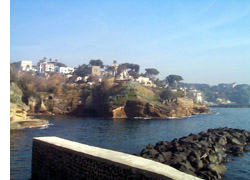 The immediate impression along the
whole stretch is of disastrous overbuilding. That impression corresponds
100% to the post-war reality of the area. Photos from the early 1900s
show a still largely wooded area with farmhouses scattered on the slope
and villas along the coast. It is, however, rewarding to keep your eye
on the string of villas that are at the waters edge (photo, right) .
They are among the most exclusive bits of property in Naples and always
have been; that is, near the cape, there are Roman ruins at waters edge.
Higher up along the cliff face, just before the cape, you can even see
the openings of the air-shafts that ventilated the Seiano Grotto that
led to the residence of Vedius Pollio
and even catch a glimpse of his amphitheater on a height. The houses
at water's edge all have at least small piers or landings, and there
are even a few small coves with breakwaters along the way. These small
harbors are the nuclei for separate, named communities such as Marecchiaro
and Gaiola. The immediate impression along the
whole stretch is of disastrous overbuilding. That impression corresponds
100% to the post-war reality of the area. Photos from the early 1900s
show a still largely wooded area with farmhouses scattered on the slope
and villas along the coast. It is, however, rewarding to keep your eye
on the string of villas that are at the waters edge (photo, right) .
They are among the most exclusive bits of property in Naples and always
have been; that is, near the cape, there are Roman ruins at waters edge.
Higher up along the cliff face, just before the cape, you can even see
the openings of the air-shafts that ventilated the Seiano Grotto that
led to the residence of Vedius Pollio
and even catch a glimpse of his amphitheater on a height. The houses
at water's edge all have at least small piers or landings, and there
are even a few small coves with breakwaters along the way. These small
harbors are the nuclei for separate, named communities such as Marecchiaro
and Gaiola.
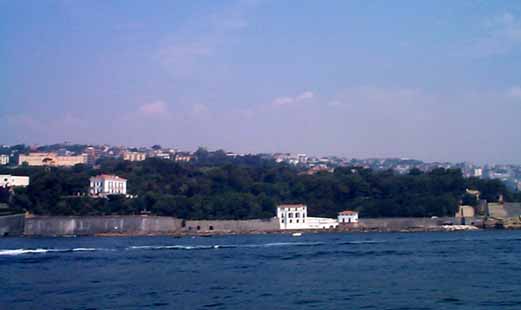 Among the many residences, fabled and not
so, along the coast, one that most attracts the eye is the Villa Rosebery
(photo, left). It is about half-way up the coast and is a fifteen-acre
wooded area dotted with a few smaller buildings such as "Small Guest
House," "Large Guest House," "Seaside Cottage" and the main building,
still referred to—in spite of the anachronism—as the "Bourbon
Palace". It is, today, the official residence of the President of the
Republic of Italy when he visits Naples. Among the many residences, fabled and not
so, along the coast, one that most attracts the eye is the Villa Rosebery
(photo, left). It is about half-way up the coast and is a fifteen-acre
wooded area dotted with a few smaller buildings such as "Small Guest
House," "Large Guest House," "Seaside Cottage" and the main building,
still referred to—in spite of the anachronism—as the "Bourbon
Palace". It is, today, the official residence of the President of the
Republic of Italy when he visits Naples.
The estate
rises over 100 feet from sea level to the back of the property. It has
a very mixed history. In 1801, an Austrian admiral in the fleet of Bourbon
Naples, Josef von Thurn (one of the officers on the court-martial board
that condemned Caracciolo to death in 1799—see here) bought the land and built on it. It was
confiscated by the Bonaparte government of Murat
in 1806 but returned to the admiral after the Restoration in 1815. He
sold the property and in 1857 it came into the hands of Luigi di Borbone,
the brother of the king of Naples. He called the property la Brasiliana
in honor of his wife, the sister of the emperor of Brazil.
At the
unification of Italy and the exile of the Bourbons, the property went
through a succession of sales and in the 1890s was bought by Archibald
Philip Primrose, 5th Earl of Rosebery (1847-1929), and British Prime
Minister for the short Liberal stewardship of the government in 1895.
He was witty, articulate, gave his name to this beautiful estate on
the Posillipo coast, fashioned much of the property along the lines
of an English garden, and then generously donated the property to the
Italian state. Among his other notable achievements, Archie owned and
raced horses and was apparently the only man to win the Derby while
serving as Prime Minister. He wasn't the jockey, I don't think, but
he did own the horse.
Gioconda,
la (Monna Lisa), Leonardo da Vinci
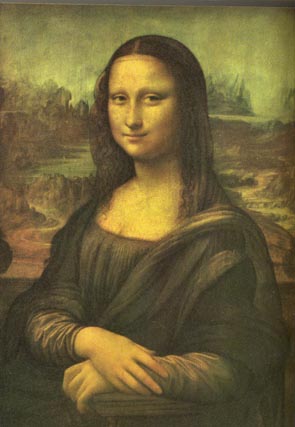 I can't find where Mona Lisa used
to live in Naples. Her surname—"Gualanda," according to one of
the many theories—is not even in the phone book, so maybe the
family has moved since 1500. I was so looking forward to making one
good prank call. I can't find where Mona Lisa used
to live in Naples. Her surname—"Gualanda," according to one of
the many theories—is not even in the phone book, so maybe the
family has moved since 1500. I was so looking forward to making one
good prank call.
What, you
ask, are the outstanding mysteries in the history of art? Well,
what is Rodin's The Thinker really thinking? Why is the Night
Watch so dark? These are puzzlers, yes, but the tough ones have
to do with Leonardo's painting erroneously known in English as Mona
Lisa (it should be Monna, a short form of Madonna, My Lady—but
we even spell mamma mia as "mama mia," so what can you expect?).
First, why is she smiling? Second, who was she?
The Why
of the Smile is anyone's guess. Nineteenth-century art historian Walter
Horatio Pater said that the Gioconda Smile was the smile of one "who
has learned the secrets of the grave." (That revelation, they say, drove
late Victorian Romantics—a notoriously melancholy bunch, anyway—even
further into white-hot frenzies of suicidal ecstasy.) One recent contribution
to scholarly thought on the subject was from a French art historian
who appeared on Italian television and claimed—with the help of
an anatomical chart—that the Smile of the Ages corresponded to
the curve of the human spinal cord, roughly from the juncture of the
first and second lumbar vertebra down to the sacrum. Naturally, you
have to rotate the spine 90 degrees from the vertical—or ask Mona
to lie down— or you'll wind up with the Frown of the Ages, but
essentially that's it: Leonardo da Vinci used someone's backbone (his
own?) as a model for the painting.
The Who
question is just as interesting and, probably, just as much up for grabs.
It is a sure thing that Leonardo did a portrait of one Lisa Gherardini
of Florence in the years 1503-1506. She married Francesco del Giocondo;
thus, the other name for the painting, La Gioconda—the
"playful one"—is a solid pun on her married name. That painting
is first mentioned and described by Giorgio Vasari in 1550 in Le
Vite de’ piv eccellenti pittori, scvltori, e architettori
(Florence 1550). He also identified the model as the "wife of Francesco
del Giocondo".
The problem
seems to be that other 16th-century descriptions of the work don't really
fit the painting we all know and wonder about. Combine that with a reference
by one Giovanni Paolo Lomazzo at the end of that century to Leonardo's
painting of a "Neapolitan Monna Lisa" and you may be led to the conclusion
that there is more than one painting and, possibly, that the one in
the Louvre is not the "wife of Francesco del Giocondo" but someone else.
An article
by Fiorenzo Laurelli in the Rivista Storica del Sannio 2000 sums
up the case for Naples by citing Carlo Vecce's 1990 article, "La Gualanda,"
in the Journal Of Leonardo Studies.
The Neapolitan model for the painting on display in the Louvre, says
Vecce, was Isabella Gualanda, born in Naples in 1491. Her mother was
Bianca Gallerani, one of Leonardo's models in another work, la dama
dell'ermellino. Isabella was orphaned and raised at the Aragonese
court. She went to Florence in 1514 and, in that year, sat for the famous
portrait. Vecce's argument is fortified behind ramparts of exhaustive
research and scholarly references. But there is still no Gualanda in
the phone book.
|
